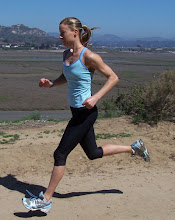Friday, May 15, 2009
Encinitas Sports Festival May 16-17
***Good luck*** to all competing in the 5K run, sprint and mini-tri, duathlon, paddle, and bike tour this weekend! I'm rooting for you!!
Sunday, May 3, 2009
Core Strength and Asymmetry in the Body

In my third year of competitive triathlon, my right hip began to seize up. I knew I had asymmetry in my hips, legs, and feet, and had been pleasantly surprised at my ability to run at all. So far I'd used weight training and yoga to build strength for triathlon.
Above Right: A chiropractic scan of my pelvis and spine (L. hipbone is solid, R. hipbone is underdeveloped and rotated anteriorly, spine connector is crooked)
But, repetitive stress eventually catches up with the body. Triathlon is 98% sagittal-plane (front-to-back) movement. The running and riding stress the hip flexors and knees like no other.
So I was leading my age group at the Camp Pendleton Triathlon one summer, and felt something was off with my right hip. I jumped off the bike...and was only able to do a moderate run/hobble to the finish. What was wrong? Was it fixable?
Core strength - I mean, true core stability and flexibility in the body pillar (abs, back, lats, glutes, hips) - changed my athletic life. I went to the best core-strength coaches in the country, super-lean and strong (you might even say ripped) from triathlon, but unable to balance properly on one leg, let alone do a single-leg squat or a lateral lunge. Also, I had no hips left - my body was straight as a boy's, and my tri shorts almost sagged off the back - not pretty.
After three weeks of serious core work, I went and raced at USAT Nationals, and had my best run off the bike so far. I didn't work harder; I simply was more mechanically efficient.
The chiropractor who did the scan above looked at me that day like I was an alien, like, "How the heck do you do triathlon?"
The answer is all in the core. You may not be able to change certain aspects of bone structure by yourself, but you can isolate and strengthen the muscle and connective tissue - to be more functional than you ever imagined. The body compensates for a weak muscle or muscle group by working another muscle too hard...and you get knots, adhesions, and PAIN. But, there's hope!
Maybe I won't be in the Olympic marathon, but I'm doing what I love, and doing it better than my bone structure would indicate!
Subscribe to:
Posts (Atom)
